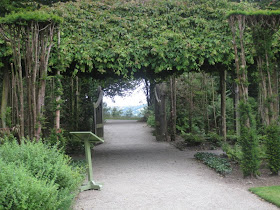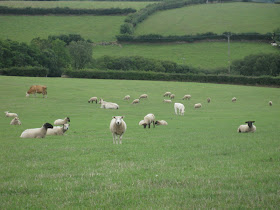The great thing about our current campground is that we can walk down the lane and find a public footpath. This morning we set out to find Spinster's Rock. I must say, we were surprised and astonished at what we found. It looks like a mini-Stonehenge.

There are competing legends, none of which make much sense. The first one says that the spinsters were not unmarried women but women who spun wool. I like that. The three standing stones are supposed to represent the three spinsters. What is more likely is that it is a Neolithic burial chamber erected around 3500-2500 BC. The top stone is massive and weighs 16 tons (how do they measure this?). Apparently it fell down during a storm in 1862 and was re-erected the same year. Now how did that happen? Were houses in the area blown down as well? It's a mystery; but we sure enjoyed finding it just sitting in a farmer's field.
We came back to the campground with plans to drive to the National Trust site, Castle Drogo. However, when the campground warden started describing the drive along a single lane with possible buses coming along for which we would have to back up and find a place to pull over, we decided to walk. He told us about a parking lot just past the turn off for the castle. We drove along the road with its high hedges, on the lookout for a blue P sign, needing to pull over at one point for a massive truck--we even had to pull in the side mirror--and this was on a "dual carriage road." Things are mighty narrow out here in the wilds of Dartmoor.
Naturally, there was no parking sign and we drove past before we realized the tiny area by the side of the road with 3 cars was probably the place. We drove for another 10 minutes before we could manage a turn around. Getting into the "parking lot" was another challenge. Backing and turning with the hope of squeezing beside another car, we finally gave up and just pulled on in hoping we could figure out how to turn around and praying no one else parked near us--which would block our escape.
This is the "wide" road leading to the parking lot.

Walking back to the public footpath that would lead to the castle, we pressed our bodies into the shrubbery, hoping the cars whipping by would see us. Once we were on the path, it was wonderful. We had the River Teign on our right and forest everywhere else.

We walked for about an hour, finally coming to another wonderful National Trust site and all it has to offer: café, wonderful docents and this time, a small binder with a page describing each room which was handed to each of us by a sweet, elderly lady. As I was studying a very intricate desk with many hidden drawers, I overheard her telling a small boy "I'll have to take your sword--everyone will be so frightened!" He was not buying it. He clutched it under his arm and stepped part way behind his mother and, with his eyes welling up, said "I won't let her keep it. I want to take it home." "But darling, I'm the boss of swords and I'll keep it in the special sword storage room." It took some doing, but he finally followed the woman to a closet and handed it over.

Castle Drogo was originally built between 1910 and 1930 for Julius Drewe, a self-made millionaire whose chain of Home and Colonial Stores enabled him to go into semi-retirement in 1899 at the age of 33.
Dramatically situated above the Teign Gorge, the castle is a granite fortress and has been called 'the last castle to be built in England' by historians.
It is believed that Drewe chose the site after discovering that the land was owned by a Norman baron named Drogo de Teign, from whom he claimed to be descended.
The foundation stone was laid on Drewe's 55th birthday in 1911 and construction took 20 years.
Sadly, Drewe died only one year after the castle was completed in 1930. Sadder still, his eldest son was killed at Ypres during WWI, an event that devastated the family and from which they never recovered. One of the rooms was a memorial to their son, with photographs lining the walls.
Drewe created an impressive family home--a bold statement that looks back to a romantic past, while heralding the modern era. The dining room had electric candle sticks, with wires hidden under a table cover and running down to the floor where they were connected to 220V of power. I wondered what would happen if someone spilled their wine.
There was a dollhouse, beautifully decorated inside with electricity and running water!

The servants rooms were fascinating and the teak kitchen sinks, designed to minimize breakage of the china, were beautiful.

The latest thing in toilets, c. 1926

Our favorite room was the library. It had three different areas: book-lined shelves, spectacular tapestries and a grand piano; a mammoth fireplace with several sofas around it; and a billiards table set in a huge corner with beautifully decorated screens making it seem as though it was another room. There was an electric soccer game that worked with switches moving the players around. We had a question for the docent and talked with him for a few minutes. Walking out of the room, we suddenly heard the piano being played. We went back in to find a young boy of about 13 playing like a professional. I overhead the docent telling the boy's mother that he had been talking to some people and didn't realize the boy was waiting to ask permission to play. We were those people.
Naturally, it had the usual formal gardens, on several levels, but I really loved the shade covering--one in each corner of the lower garden.



Several levels further on was a huge circular lawn set up for croquet.

We finished at the café with a nice lunch, relaxing for awhile before the hike back.
What is it about sheep? I can't get enough of them. This one in the middle stood and stared for as long as we watched.

I will never get tired of these velvety looking fields. Talk about bucolic.

Suspension bridge across the River Teign

An Englishman's home is his castle. ~ English Proverb
Sounds like Claire has truly fallen in love w/ the British Isles, complete w/ Larson-esque sheep and velvetty fields...
ReplyDeleteGorgeous fotos once again; your cameras deserve a footnote for co-starring on this journey! Nikon?
Thanks!
ReplyDeleteCanon PowerShot SD890 IS